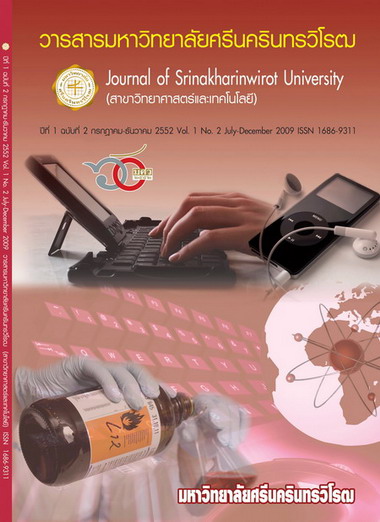การพัฒนางานออกแบบหัตถกรรมจากกรรมวิธีการทำเครื่องเขิน (THE DEVELOPMENT OF CRAFT FROM LACQUER WARE PRODUCTION PROCESS)
Abstract
บทคัดย่อ
งานหัตถกรรมเครื่องเขินเป็นภูมิปัญญาท้องถิ่นและแสดงถึงอัตลักษณ์เฉพาะของชาวล้านนามาแต่อดีตกาล งานวิจัยครั้งนี้จึงมีวัตถุประสงค์ 1) เพื่อศึกษา สำรวจ และรวบรวมข้อมูล งานหัตถกรรมเครื่องเขินล้านนาที่เป็นภูมิปัญญาท้องถิ่นไม่ให้สูญหายไป 2) เพื่อศึกษาค้นคว้าทดลองพัฒนาวัสดุและกระบวนการผลิตเครื่องเขินให้มีความเหมาะสมกับการผลิตเพื่อจำหน่ายในตลาดปัจจุบัน 3) เพื่อพัฒนางานออกแบบหัตถกรรมให้มีรูปแบบประโยชน์ใช้สอย ลวดลาย วัสดุและกรรมวิธีการผลิตให้เหมาะกับความต้องการของผู้ใช้เป็นผลิตภัณฑ์เครื่องเขินร่วมสมัย ประชากรและกลุ่มตัวอย่างที่ใช้ในการวิจัยครั้งนี้ คือ 1) กลุ่มสำหรับศึกษาข้อมูล ได้แก่ ผู้ผลิต และผู้จำหน่ายเครื่องเขินล้านนาภาคเหนือตอนบน และผู้ผลิตเครื่องเขินในแคว้นเชียงตุง รัฐฉานตะวันออกของประเทศเมียนมาร์ 2) กลุ่มสำหรับวิเคราะห์ข้อมูลทางด้านการตลาดและการประเมินผลิตภัณฑ์ต้นแบบ ได้แก่ ผู้ผลิต ผู้จำหน่าย และผู้เชี่ยวชาญด้านงานหัตถกรรมเครื่องเขิน กลุ่มตัวอย่างผู้วิจัยใช้วิธีแบบเจาะจงโดยพิจารณาจากชุมชนชาวไทยเขินในจังหวัดเชียงใหม่
ผลการวิจัยแบ่งออกเป็น 3 ส่วน ดังต่อไปนี้
1. การศึกษา สำรวจงานหัตถกรรมเครื่องเขิน พบว่า 1) ประวัติความเป็นมาของงานเครื่องเขิน มีจุดกำเนิดมาจากจีน และมีการขยายตัวของเครื่องเขินลงมาทางตอนใต้ และตะวันออกของจีน สู่ประเทศต่างๆ ในแถบเอเซีย โดยมีการถ่ายทอดกรรมวิธีเทคนิคการทำเครื่องเขินลักษณะต่างๆ ในแต่ละช่วงเวลาของประวัติศาสตร์ ส่วนงานเครื่องเขินล้านนานั้นผู้ผลิตงานเครื่องเขินเป็นชุมชนที่สืบเชื้อสายมาจากชาวไทยเขินที่ถูกกวาดต้อนมาจากเมืองเชียงตุงในสมัยพระเจ้ากาวิละ 2) จังหวัดเชียงใหม่เป็นศูนย์กลางการผลิตงานเครื่องเขินอยู่บริเวณชุมชนวัดนันทาราม ตำบลหายยา อำเภอเมือง จังหวัดเชียงใหม่ และบริเวณถนนเชียงใหม่-สันกำแพง ส่วนเครื่องเขินเชียงตุงมีการผลิตและจำหน่ายงานเครื่องเขินอยู่ที่บ้านจอมมนในตัวเมืองเชียงตุงผู้ผลิตเป็นชาวไทยใหญ่ (Shan) 3) วัสดุและกรรมวิธีการผลิตงานเครื่องเขิน ประกอบด้วย (1) ยางรัก ชาวล้านนาได้มาจากต้นรักใหญ่ (2) วัสดุทำโครงเครื่องเขิน ได้แก่ ไม้ไผ่เฮียะ ไม้มะม่วงและไม้ฉำฉา (3) การเคลือบยางรักมีวัตถุประสงค์เพื่อเพิ่มความแข็งแรงให้กับโครงเครื่องเขินและปกปิดพื้นผิวให้เรียบและเป็นมันเงางาม (4) การเขียนลายเครื่องเขินมีเทคนิคการเขียนลายอยู่ 4 แบบ ได้แก่ ลายรดน้ำ ลายขุด ลายเขียนสี และลายเปลือกไข่ ส่วนเครื่องเขินเชียงตุงใช้วัสดุทำโครงเครื่องเขินจากไม้ไผ่เฮียะ รวมถึงขั้นตอนการเคลือบชิ้นงานด้วยยางรักเหมือนกันกับเครื่องเขินล้านนา และการตกแต่งลวดลายเครื่องเขินใช้เทคนิคการทำลายนูน (Thayo)
2. การวิเคราะห์และทดลองวัสดุ พบว่า การทดลองพัฒนาคุณภาพวัสดุที่ใช้ผลิตงานหัตถกรรมเครื่องเขิน เพื่อให้มีความเหมาะสมกับสภาพปัญหา และความต้องการในปัจจุบัน โดยผลการทดลองมีส่วนสำคัญที่พบ จำแนกเป็น 3 ประเด็น คือ 1) โครงสร้างชิ้นงานเครื่องเขินผลิตจากวัสดุสังเคราะห์ และวัสดุธรรมชาติ 2) สูตรการเคลือบผิวโครงชิ้นงานเครื่องเขินโดยใช้สารเคลือบผิวสังเคราะห์ทดแทนยางรักได้ 3) สูตรการตกแต่งลวดลายบนชิ้นงานเครื่องเขิน จากวัสดุสติกเกอร์ เมล็ดพันธุ์พืช และขี้เลื่อยไม้ยางพาราสามารถนำมาประยุกต์ใช้เพื่อเพิ่มมูลค่าได้
3. การออกแบบและพัฒนางานหัตถกรรมเครื่องเขินร่วมสมัย พบว่า 1) ด้านกรรมวิธีการขึ้นรูปชิ้นงานเครื่องเขินนั้นจำเป็นที่จะต้องมีความสอดคล้องและเหมาะสมกับลักษณะรูปทรงของวัสดุที่ใช้ผลิตโครงเครื่องเขิน 2) ด้านข้อมูลการตลาดเพื่อใช้เป็นข้อมูลในการออกแบบ พบว่า ผู้ซื้องานเครื่องเขินเป็นเพศหญิง และเพศชาย จำนวนพอๆ กัน มีอายุระหว่าง 41-50 ปี ส่วนใหญ่ เลือกซื้องานเครื่องเขิน ประเภทของตกแต่งบ้าน รองลงมา คือ ประเภทของที่ระลึก ประเภทของใช้ และประเภทเครื่องประดับตามลำดับ รูปแบบ ลวดลายเป็นงานเครื่องเขินประยุกต์ร่วมสมัย เป็นเทคนิคลายทองรดน้ำ และราคาจำหน่ายงานเครื่องเขินเริ่มต้นที่ 100 บาท ขึ้นไป 3) ด้านแนวความคิดในการออกแบบ จะต้องคำนึงถึง 2 ด้าน คือ (1) ปัจจัยภายใน ได้แก่ วัสดุและกรรมวิธีการผลิต ประโยชน์ใช้สอยและรูปทรง (2) ปัจจัยจากภายนอก ได้แก่ การแข่งขันทางการตลาด ความสามารถเข้ากันได้กับระบบสากล การควบคุมด้านความปลอดภัย และการอนุรักษ์ทรัพยากรธรรมชาติและสภาพแวดล้อม
Lacquer ware is created from local wisdom and has been considered Lanna identity since ancient times. Therefore, this research aimed to 1) study, survey and collect data of lacquer ware, Lanna local wisdom, in order to conserve this kind of art; 2) to experiment on development of materials and lacquer ware production process to suit the current market, and 3) to develop the contemporary design of lacquer ware including style, usage, painting, materials and lacquer ware production process to meet the customers’ needs. The population and sample of this study were 1) Data Collection Group manufacturers and suppliers of lacquer ware in the upper northern part of Thailand; and manufacturers in Keng Tung in Chan State which is situated in the east of Myanmar; 2) Data Analysis Group for marketing and evaluating lacquer ware models namely, manufacturers, suppliers and experts in lacquer ware. Purposive sampling of Tai Khuen in Chiangmai was used in this study.
The results were as follows:
1. The investigation found that: 1) lacquer ware originated in China, then expanded to the south, the east and other Asian countries, with different techniques for lacquer ware manufacturing in different historical times while makers of Lanna lacquer ware were derived from Tai Khuen captives brought from Keng Tung during King Kawila’s reign, 2) lacquer ware manufacturing areas in Chiangmai were situated in Nantaram Temple community, Tambon Haya, Amphur Muang and along Chiangmai-Sankamphaeng Road. In Keng Tung, lacquer ware was produced and sold in Baan Chom Mon by Chan people, 3) materials and process of lacquer ware production consisted of: (1) lacquer resin taken from big lacquer trees by Lanna people, (2) materials used to make lacquer ware base which were ‘bamboo hia’ (phai hia), mango wood and monkey pod or rain tree wood, (3) the purpose of coating lacquer ware with lacquer resin which was to give the objects sturdy, smooth and shiny surface, (4) four types of lacquer ware decoration-Lai Rot Nam or gold gilding, Lai Kud or filled lacquer, color painting and egg shells inlay. Similarly, Keng Tung lacquer ware was made from ‘bamboo hia’ and coated with lacquer resin like Lanna lacquer ware. However, the decoration was called Lai Noon (Thayo).
2. Materials experiment and analysis found that: 1) lacquer ware base was made from two kinds of materials-artificial materials and native natural raw materials, 2) artificial materials could be used to coat lacquer ware instead of lacquer resin, 3) it was found that a new decoration and painting design for lacquer ware using stickers, plant seeds and rubber tree sawdust could be used to add value to the objects.
3. For contemporary design and development, it was found that: 1) method of setting lacquer ware base should correspond to the materials, 2) collected marketing data revealed that there were similar numbers of male and female customers aged between 41-50. Most of them purchased lacquer ware for home decoration. The rest purchased the products for souvenirs, home appliances and ornaments. Contemporary gold gilded lacquer ware was preferred. Selling price started from 100 baht, 3) two factors should be taken into account for lacquer ware design: (1) Internal Factors-These were materials and production method, usefulness and products shapes, (2) External Factors-These included competitiveness, compatibility with international system, safety control, and natural resource and environment conservation.
Downloads
Downloads
Published
How to Cite
Issue
Section
License
Srinakharinwirot University Journal of Sciences and Technology is licensed Under a Creative Commons Attribution-NonCommercial-NoDerivs 4.0 International (CC-BY-NC-ND 4.0) License, Unless Otherwise Stated. Please Read Journal Policies Page for More Information on Open Access, Copyright and Permissions.



